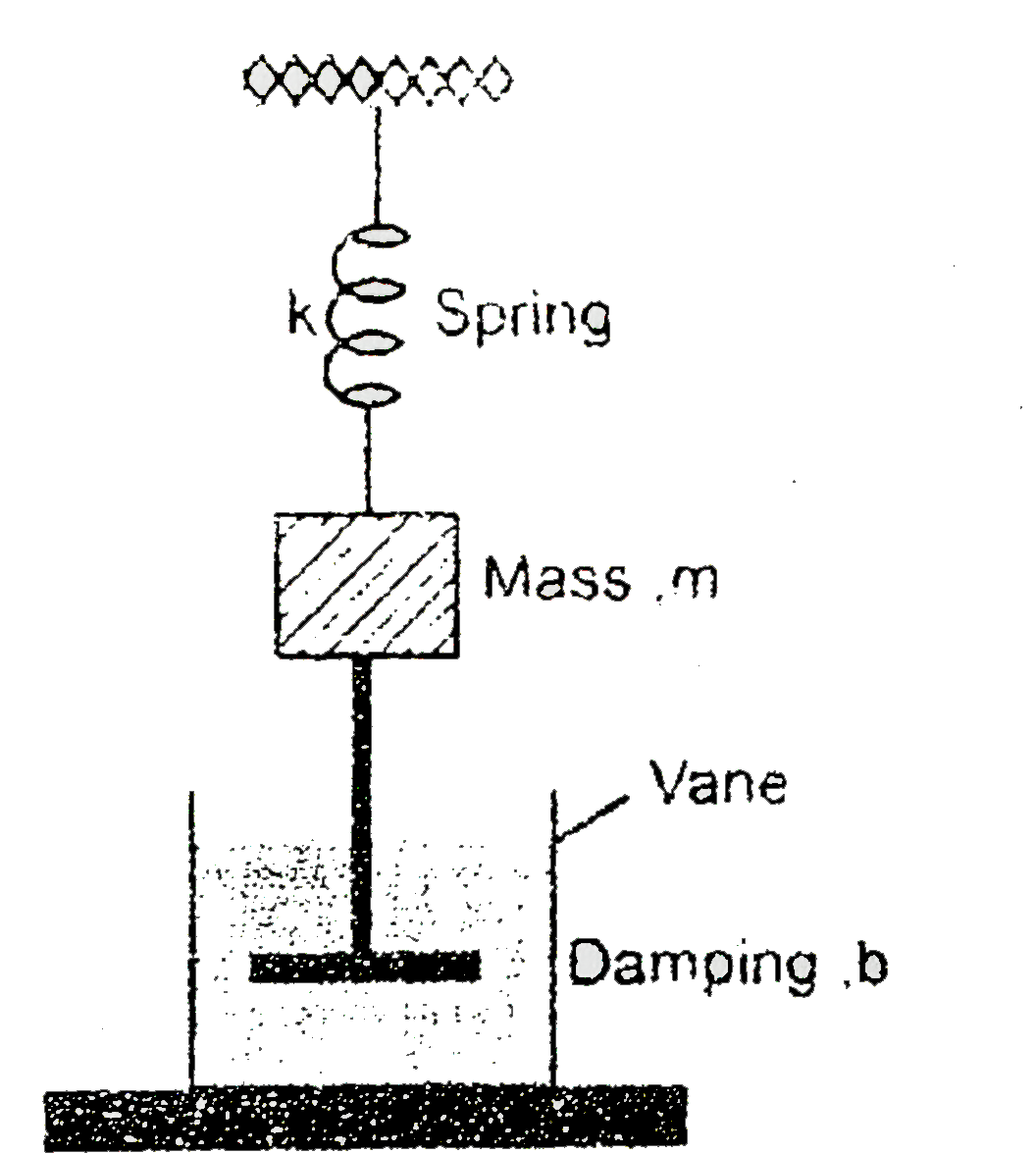For the damped oscillator of Fig. 15.20, m= 250g, k= 85N/m, and b= 70g/s
What is the period of the motion?
To find the period of the damped oscillator, we can use the formula for the period of a damped harmonic oscillator. However, since the damping is relatively small in this case, we can approximate the motion as simple harmonic motion (SHM) and use the formula for the period of a simple harmonic oscillator.
1. Identify the given values:
- Mass (m) = 250 g = 0.250 kg (convert grams to kilograms)
- Spring constant (k) = 85 N/m
- Damping coefficient (b) = 70 g/s = 0.070 kg/s (convert grams to kilograms)
2. Calculate the natural frequency (ω₀):
The natural frequency of a simple harmonic oscillator is given by:
ω0=√km
Substituting the values:
ω0=√85N/m0.250kg=√340≈18.44rad/s
3. Calculate the damping ratio (ζ):
The damping ratio is given by:
ζ=b2√mk
First, calculate 2√mk:
2√mk=2√0.250×85=2√21.25≈9.19
Now, calculate the damping ratio:
ζ=0.0709.19≈0.0076
4. Determine the damped frequency (ω_d):
Since the damping ratio is very small, we can approximate the damped frequency as:
ωd≈ω0√1−ζ2≈ω0(since ζ is very small)
Therefore,
ωd≈18.44rad/s
5. Calculate the period (T) of the damped oscillator:
The period of the damped oscillator is given by:
T=2πωd
Substituting the value of ωd:
T=2π18.44≈0.34s
Final Answer:
The period of the motion is approximately 0.34 seconds.
- Mass (m) = 250 g = 0.250 kg (convert grams to kilograms)
- Spring constant (k) = 85 N/m
- Damping coefficient (b) = 70 g/s = 0.070 kg/s (convert grams to kilograms)
The natural frequency of a simple harmonic oscillator is given by:
ω0=√km
Substituting the values:
ω0=√85N/m0.250kg=√340≈18.44rad/s
The damping ratio is given by:
ζ=b2√mk
First, calculate 2√mk:
2√mk=2√0.250×85=2√21.25≈9.19
Now, calculate the damping ratio:
ζ=0.0709.19≈0.0076
Since the damping ratio is very small, we can approximate the damped frequency as:
ωd≈ω0√1−ζ2≈ω0(since ζ is very small)
Therefore,
ωd≈18.44rad/s
The period of the damped oscillator is given by:
T=2πωd
Substituting the value of ωd:
T=2π18.44≈0.34s
The period of the motion is approximately 0.34 seconds.
Topper's Solved these Questions
- BOOK - RESNICK AND HALLIDAYCHAPTER - OSCILLATIONSEXERCISE - Checkpoint8videos
OSCILLATIONS
- BOOK - RESNICK AND HALLIDAYCHAPTER - OSCILLATIONSEXERCISE - Problems39videos
OSCILLATIONS
- BOOK - RESNICK AND HALLIDAYCHAPTER - MOTION IN TWO AND THREE DIMENSIONSEXERCISE - PRACTICE QUESTIONS (MATRIX-MATCH)10videos
MOTION IN TWO AND THREE DIMENSIONS
- BOOK - RESNICK AND HALLIDAYCHAPTER - PHOTONS AND MATTER WAVESEXERCISE - PRACTICE QUESTIONS(Integer Type)4videos
PHOTONS AND MATTER WAVES
Similar Questions
For the damped oscillator of Fig. 15.20, m= 250g, k= 85N/m, and b= 70g/s
How long does it take for the amplitude of the damped oscillations to drop to half its initial value?View SolutionFor the damped oscillator of Fig. 15.20, m= 250g, k= 85N/m, and b= 70g/s
How long does it take for the mechanical energy to drop to one-half its initial value?View Solution
Knowledge Check
- Question 1 - Select One
For a damped oscillation m=500 gm ,k=100 N/m,b=75 gm/sec. What is the ratio of amplitue of damped oscillation to the intial amplitude at the end of 20 cycles
⎡⎢⎣given1e0.675=0.5,1e0.51=0.6⎤⎥⎦A0.6B0.51C0.4Dnone - Question 2 - Select One
A horizontal platform with an angular placed on it is executing S.H.M. in the vertical direction .The amplitude of oscillation is 4.0×10−3m. What must be the least period of there oscillation so that the object is not stretched from the platform ? (Taking g=10m/s2)
Aπ25secBπ18secCπ14secDπ20sec - Question 3 - Select One
An oscillator consists of a block attached to a spring of spring constant K=300 N/m. At some time t the position (measured from its equilibrium position), velocity and acceleration of the block are
x=0.1m,v=−15m/s and a=−90m/s2. What is the ampliof motion and the mass of the block ?A0.3 m and 0.3 kgB0.4 m and 14kgC0.5 and 13kgD0.5m and 14kg
Here are three sets of values for the spring constant, damping constant, and mass for the damped oscillator of Fig. 15.17. Rank the sets according to the time required for the mechanical energy to decrease to one-fourth of its initial value, greatest first.
¯¯¯¯¯¯¯¯¯¯¯¯¯¯¯¯¯¯¯¯¯¯¯¯¯¯¯¯¯¯Set 12k0 b0 m0Set 2 k0 6b0 4m0Set 33k0 3b0 m0–––––––––––––––––––––View SolutionFor the damped oscillator shown in Fig, the mass of the block is 200g,k=80Nm−1 and the damping constant b is 40gs−1 Calculate
(a) The period of oscillation
(b) Time taken for its amplitude of vibrations to drop to half of its initial values
(c) The time for the mechanical energy to drop to half initial values
 View Solution
View SolutionA 50g mass hangs at the end of a massless spring. When 20g more are added to the end of the spring, it stretches 7.0cm more. (a) Find the spring constant. (b) If the 20g are now removed, what will be the period of the motion ?
View SolutionFor the damped oscillator shown in previous figure, k=180Nm−1 and the damping constant b is 40gs−1 .Period of oscillation is given as 0.3 s, find the mass of the block . (Assume b is much less than √km).
Hint :T=2π√mkView SolutionFor a damped oscillator the mass 'm' of the block is 200 g, k = 90 N m−1 and the damping constant b is 40 g s−1. Calculate the period of oscillation.
View Solution

